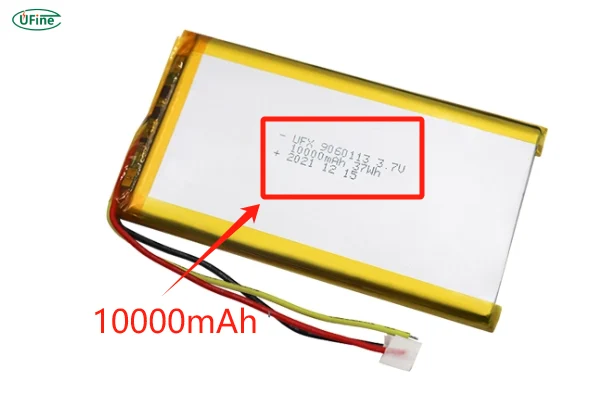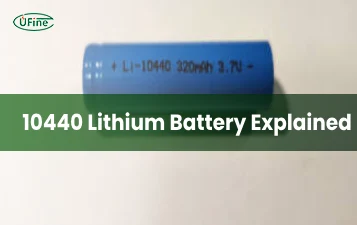Part 1. What does mAh mean?
First, let’s talk about mAh—or milliampere-hour. It’s not just some number on a label. It tells you how much electric charge a battery can store. Think of it like a fuel tank. The bigger the number, the more power it holds.

A 10000mAh battery, in theory, can deliver 10,000 milliamps for one hour, 1,000 milliamps for 10 hours, or 100 milliamps for 100 hours. It all depends on the device it’s powering. But remember, real-world usage involves power losses, so actual performance may vary.
Part 2. The chemistry types
When people talk about high-capacity batteries, they often mean lithium-ion (Li-ion) or lithium polymer (LiPo) batteries. Both use lithium as the base chemistry, but they have some key differences.
- Li-ion batteries are the most common. They have high energy density, excellent rechargeability, and a stable voltage output. A 10000mAh li-ion battery is often found in power banks, tablets, and other portable devices.
- LiPo batteries, on the other hand, use a gel-like electrolyte. They are lighter, more flexible in shape, and often used in drones and compact gadgets.
So which should you choose? If you value durability and higher energy capacity, go for 10000mAh Li-ion. If your device has tight space or weight limits, a 10000mAh LiPo battery might be the better fit.
And if you’re looking for tailored solutions, Ufine Battery offers both Li-ion and LiPo options in various sizes, voltages, and configurations. As a trusted Chinese lithium battery manufacturer, Ufine provides custom battery packs for consumer electronics, industrial tools, and more.
Part 3. What about voltage?
Now that we’ve tackled capacity, let’s talk voltage. Most 10000mAh batteries operate at 3.7V, which is the standard for a single Li-ion cell. However, some packs may be configured in series to output 7.4V, 11.1V, or more.
The voltage directly impacts how much power (in watt-hours) the battery can deliver. Here’s a simple formula:
Watt-hours (Wh) = Voltage (V) × Capacity (Ah)
So, a 10000mAh (which is 10Ah) 3.7V battery equals:
3.7V x 10Ah = 37Wh
This is crucial if you need to calculate energy use for more demanding applications.
Part 4. How long can a 10000mAh battery run? How to calculate it?
This is what everyone wants to know. The answer depends on the device you’re powering and how much current it draws.
Use this formula:
Run Time (hours) = Battery Capacity (mAh) / Device Load (mA)
Example: If your device uses 500mA, a 10000mAh battery will run it for:
10000 / 500 = 20 hours
However, that’s a best-case scenario. Heat, power conversion losses, and battery aging can shorten that.
Still, it’s a solid estimate to help you understand what kind of power you’re getting.
Part 5. 3.7V 18650 10000mAh battery vs. 10000mAh LiPo: which one?
A 10000mAh 18650 battery pack is usually made up of multiple 18650 cells in parallel. These are great if you want a rigid, durable battery.
On the other hand, a 10000mAh LiPo battery is flat, lightweight, and customizable in shape. These are often used in drones, tablets, and compact electronics.
Choose 18650 if:
- You need high energy output and long cycle life
- The shape and weight are not critical
Choose LiPo if:
- Space-saving is essential
- Your device is sensitive to weight or size
Still unsure which to pick? Ufine Battery can help you choose and customize the right format for your product. With expertise in 18650 packs, LiPo cells, and advanced lithium battery technology, they deliver quality you can count on.
Part 6. Is a bigger battery always better?
We’ve all been tempted by big numbers. More mAh must be better, right? Not always.
A bigger battery means more weight, longer charging time, and higher cost. If your device only needs 3000mAh, then a 10000mAh battery is overkill. It might even damage your device if the voltage or size doesn’t match.
Instead, choose the battery that fits your real needs. Think about runtime, usage habits, and portability. That’s the smart way.
Part 7. What’s the price?
Prices vary based on chemistry, brand, and build quality. Here’s a rough guide:
- Basic 10000mAh Li-ion cell: $8 to $15
- Branded power banks: $15 to $40
- Custom industrial packs: $30 to $80 or more
Beware of deals that look too good. Quality matters. Cheap batteries can fail early or even pose safety risks. Always buy from trusted suppliers.
If you need high-quality custom packs, Ufine Battery offers affordable, certified lithium battery solutions for various applications. They’re known for working closely with clients to meet performance, safety, and size needs.
Part 8. Final thoughts: Is the 10000mAh battery worth it?
In many cases, yes—a 10000mAh battery gives you excellent runtime without being too bulky. It’s a favorite for power users, travelers, and anyone who hates being tethered to a wall socket.
A 10000mAh li-ion battery provides long-lasting power with a reliable performance profile. Whether you’re using it in a power bank, custom gadget, or backup system, it’s a smart investment for most people.
Just make sure to choose the right format and voltage. And don’t forget—safety and quality always come first.
If you’re looking for a trusted battery supplier, Ufine Battery is here to help. As a leading Chinese custom lithium battery manufacturer, they offer a wide range of LiPo batteries, LiFePO4 cells, cylindrical batteries, ultra-thin formats, high-rate models, and even high-temperature options.
Need a custom lithium battery solution? Contact Ufine Battery today and get expert support tailored to your needs.
Your devices deserve power you can count on. Now you know exactly what to look for.
Part 9. FAQs
How many times can it charge a phone?
If your phone has a 3000mAh battery, a 10000mAh power bank can charge it about 2.5 to 3 times, considering some energy loss.
Is it safe to fly with a 10000mAh battery?
Yes. Most airlines allow batteries under 100Wh. A 10000mAh 3.7V battery is 37Wh, which is within limits.
How long does it take to recharge?
With a standard 2A charger, it may take 5-6 hours. Faster charging depends on your battery’s input rating.
How long will the battery last before it degrades?
Most Li-ion batteries last 300-500 full charge cycles. After that, you’ll see reduced capacity.
Can I replace my original battery with a 10000mAh one?
Only if the voltage and dimensions match. Otherwise, it could damage your device.
Related Tags:
More Articles

10440 Battery Guide: Size, Voltage, Capacity, Uses & More
Understand 10440 batteries better—size, voltage, safety, and how they compare to AAA. Find the best fit for your high-performance devices.
White Stuff on Battery Terminals: A Step-by-Step Cleaning and Maintenance Guide
White stuff on battery terminals is corrosion. Learn how to clean it safely, prevent damage, and keep your battery running strong with simple steps.
Understanding How Glass Mat Batteries Work: Technology, Benefits, and Limitations
Glass mat batteries power cars, RVs, and solar systems. Learn how they work, their benefits, and what to consider before choosing one.
A Buyer’s Guide for AA Size Lithium Battery
Discover the power of AA size lithium batteries—types, voltage, capacity, and more! Learn how to choose the best one for your needs. Read now!
Li-Ion Battery Prices – Where to Buy Cheap & Safe
Discover li-ion cell prices, key market factors, and how to find affordable custom batteries from top suppliers like Ufine Battery.





